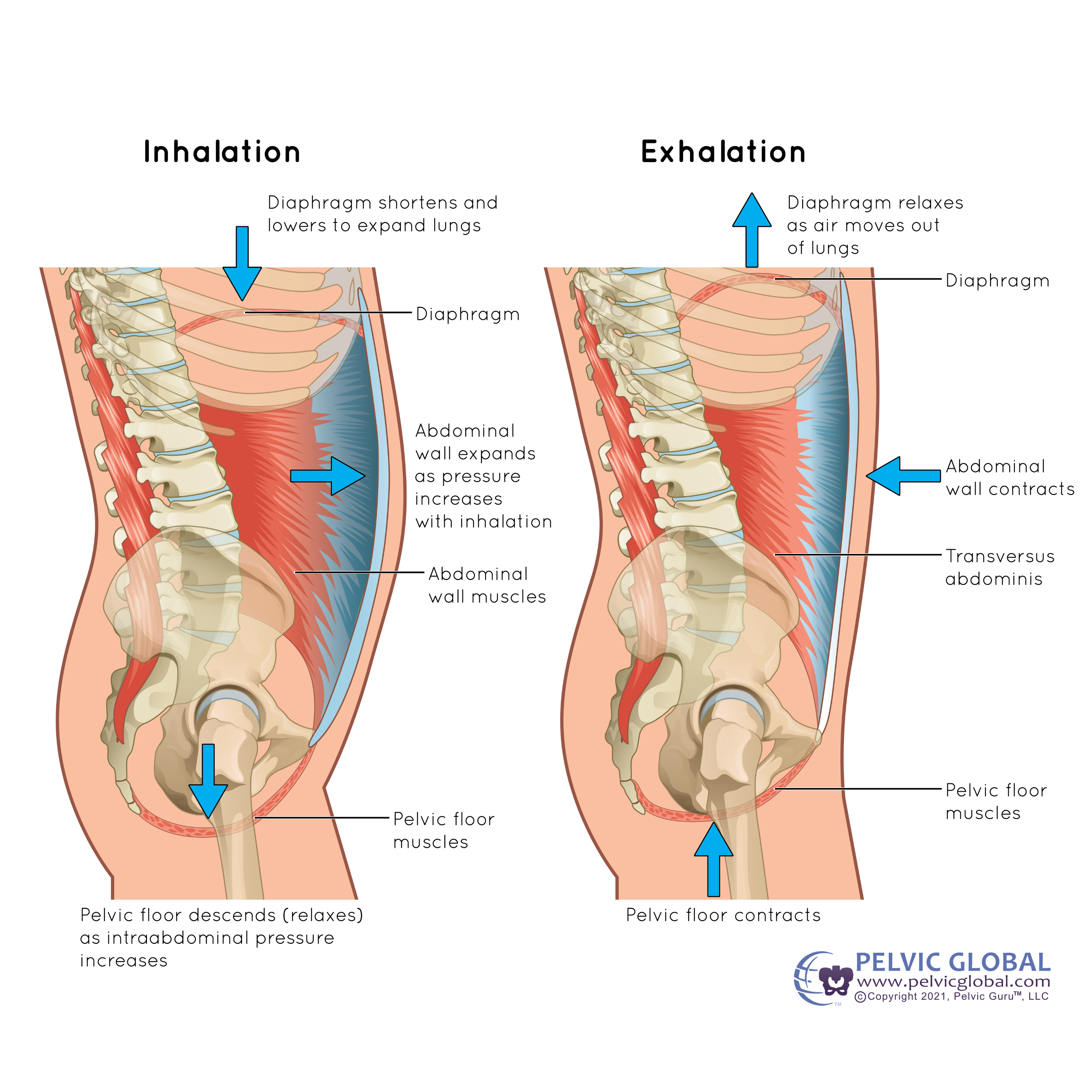Wider Ribs After Kids: Everything You Need to Know About Rib Flare

Having a baby changes pretty much everything about your life — including your body. Of course, we’re all familiar with belly stretch marks and changing breast sizes during pregnancy and postpartum as our bodies change through each stage. But these commonly known changes aren’t the only ones you might experience!
Ever reached for your pre-pregnancy bras a few months postpartum and thought, “Hmmm, these feel tight — not in the cup, but in the band!”? Weight fluctuation isn’t always the culprit. If your trunk feels wider after having kids, you might be experiencing rib flare. The shape and size of your ribcage can actually change over time. But before we unpack how and why, let’s zoom out to your entire inner core and how it works, especially during pregnancy.
How your inner core works
Your core is so much more than just “visible abs”. In fact, your entire abdominal cavity is considered the core of your body, and it keeps your organs (and your baby during pregnancy!) safe through a pretty incredible pressurization system.
Think of your core like a can of soda. Your pelvic floor holds everything in from the bottom, your diaphragm sits at the top, and your abdominal and back muscles are the walls around the sides of your internal organs.

Image used with permission from Pelvic Guru®, LLC as a member of the Global Pelvic Health Alliance Membership (GPHAM)
When this system functions correctly, your pelvic floor, diaphragm, and ab and back muscles work in tandem to create intra-abdominal pressure. When one of these parts doesn’t function properly, though, you run into problems.
If your pelvic floor muscles can’t withstand the pressure coming from your abdomen over time, you might experience prolapse. If your pelvic floor is too tight, you might not be able to control your bathroom habits optimally, leading to stress or urge incontinence.
What does this have to do with breathing?
Your intra-abdominal pressure also affects your breathing — and vice versa. We all breathe without even thinking about it, but our bodies actually have some very important breathing mechanics that keep air flowing in and out.
When you inhale, your diaphragm contracts and flattens, moving downwards to create a vacuum to draw air into your lungs. As oxygen enters your body, your ribs expand up and out like a bucket handle. And while the diaphragm lowers, the pelvic floor lowers, too, so that you can maintain the right amount of pressure in the system. All pretty cool for something you never have to think about, right?
When you exhale, your diaphragm relaxes and returns upwards to its resting state, and your ribs return back down and in. Your pelvic floor will naturally rebound as well, just like a slow-motion trampoline. Inm a way, the diaphragm and pelvic floor work together like a piston. On an inhale, they both expand and lower. On an exhale, they both rebound and rise.

Image used with permission from Pelvic Guru®, LLC as a member of the Global Pelvic Health Alliance Membership (GPHAM)
Rib changes during pregnancy
So, you know how your whole abdominal pressure system works. But what happens to it during pregnancy?
As your uterus expands to make room for a growing baby, the “walls” of your abdominal soda can stretch and move along with it. Research suggests that ribs expand an average of about 2-3 inches during pregnancy, because the diaphragm is displaced upwards and outwards. This can leave your body in a state of “inhalation” even when you’re not breathing in! Your diaphragm stays flattened instead of relaxing and returning to its dome-like shape when your ribs move back inward on an exhale.
The uterus and baby constantly pushing up on diaphragm can make it harder for you to take a deep breath, which is why you often feel short of breath during pregnancy. The downward movement of your diaphragm is actually harder due to rib cage expansion and stiffness in your ribs, side body, and upper back as you adjust to a crowded abdominal cavity and carrying a heavier weight.
This is why I recommend introducing maternity bras early in pregnancy to accommodate your growing rib cage and reduce excessive pressure and constriction! That tight squeeze of pre-pregnancy bras can often cause rib pain. I personally love the maternity bras from Bodily — they have a variety of options based on the kind of support you need! My go-to during pregnancy is The Effortless Bra. During postpartum, I am constantly wearing The Do Anything Bra because of the hands-free pumping feature along with front clip nursing access.
What is rib flare?
Pregnancy is not the only cause of rib flare, but it’s a very common one! Many postpartum women come to a doctor or physical therapy with wider ribs and discomfort or pain. And rib flare can truly affect your pelvic floor and core!
Before today, you might not have considered the relationship between your ribcage and your pelvic floor, but trust me: it’s an important one!
That “piston” system of your diaphragm and pelvic floor really matters — they need to move together to keep the right amount of tension in your core. As I’ve already mentioned, uneven distribution of pressure can contribute to things like prolapse, diastasis and urinary incontinence, and we all want to stop those problems before they even begin if we can!
The term “rib flare” actually encompasses two different situations — the position of your ribs and the angle of your ribs.
Positional Rib Flare
This type of rib flare is largely due to posture and the position of your ribs. The good news: this type is typically an easy fix, because it just requires a change in your posture!
During postpartum, it’s common to thrust your hips forward, tuck your butt and round your upper back. Your ribs should be stacked over your pelvis, and this posture makes that pretty much impossible! To improve the diaphragm, core and pelvic floor relationships, and hit reset on your pressurization system, focus on stacking your ribs and maintaining neutrality in your back, hips, and glutes.
Wide Infrasternal Angle (ISA) Rib Flare
Sometimes, rib flare can be a little more complex than simple position changes. When you’re stuck in that inhalation state I mentioned earlier, your ribs are fixed at a wider infrasternal angle (ISA) than they should be. When physical therapists talk about measuring ISA, we’re looking at the angle of your lower sternum — specifically, the angle between your xyphoid process at the bottom of your sternum and the left and right sides of the bottom of your ribcage. Ideally, we want to see that angle measuring around 90 degrees.
Technically, it’s not classified as rib flare unless the angle is wider than 110. (You can also have a narrow infrasternal angle, but we will save that for another post!)
All women have a wider ISA during pregnancy, but sometimes, your ribs need assistance in the form of guided rehab and specific exercise to return to the proper angled state. You have muscles that attach between and on your ribs. These muscles help pull the ribs down as you exhale, which means it takes more than just changing your posture to address this type of rib flare.
My favorite helpful breathing exercise
If you’re experiencing wide ISA rib flare, this breathing exercise can help. While you’re seated, practice diaphragmatic breathing — and add in manual overpressure to the ribs using a band. It’s easier to show than tell with this exercise, so here’s a video with audio cues for you to follow along!
P.S. This video is taken directly from my Movement Through Early Postpartum program where every exercise has both audio and written cues to ensure your success!
Reduce postpartum pain and discomfort
Rib flare is just one of the many uncomfortable parts of postpartum, and I want to be here to help you heal from all of them. I created Movement Through Early Postpartum to help new mamas address pain and discomfort, restore the core and pelvic floor, recover from childbirth, learn how to get moving safely again, and reclaim control of your body after so many changes.
I know pregnancy and postpartum can feel overwhelming, and I want to be your helpful guide and trusted fellow mom as you move through those early stages of postpartum recovery. In this program, you’ll find more than 40 helpful educational modules to address common postpartum concerns, along with safe and gentle movements to help you heal and recover effectively.
Postpartum recovery doesn’t have to be a mystery.
Wow, you are soooo knowledgeable! I first heard about u thru the Olympic gymnast….Shawn Johnson. I am a former ballet teacher and so many things u teach about the core,ribs,and pelvis are amazing!! Thank you for helping so many women!!!
Hi Martha! I’m so so honored you are here! Thank you for being a part of this community!
Can rib flare contribute to a shortness of breath feeling during postpartum as well?
Hi Kate! YES it definitely can because it is hard to take a full deep breath in the expanded state of inhalation.
Can run flare be worse on one side? I feel more discomfort and angle on my right side.
I am having the same issue! It just recently started and my baby is 7 months.
I have tried everything I am not sure what it is but I hope its this and I can do these exercises. It fills like part of my right side goes under my rib cage when I lay down and its uncomfortable.
It totally can be worse on one side!! Your muscles can be tighter on one side making it harder to access expansion. Conversely you can have weaker intercostals and obliques on one side leaving them more flared.
Can wide angle rib flare be completely corrected using this breathing technique?
Hi! Rib flare can be quite multifactorial, so the breathwork is definitely where I would start for improvement, but it might not completely resolve the issue if you’re lacking core strength.
Does rib flare contribute to shoulder widening?
Hi! Yes it absolutely can contribute to a wider appearance of your entire chest which would then contribute to a wider appearance of your shoulders!